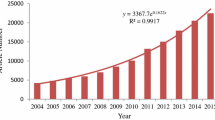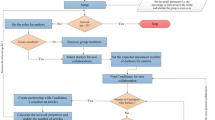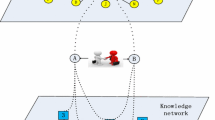Abstract
This study on co-authorship networks in the area of nanostructured solar cells aims to contribute to a further understanding of the use of research evaluation measures of science output, impact and structure in an emerging research field. The study incorporates quantitative bibliometric methods of analysis and social network analysis in combination with a qualitative case study research approach. Conclusions drawn from the results emphasise, firstly, the importance of distinguishing between early and later phases of the evolution of a novel research field, and secondly, the application of a systemic view on learning processes and knowledge diffusion in a science-based technology field.
Similar content being viewed by others
References
Arnall, H. A. (2003), Future Technologies, Today’s Choices: Nanotechnology, Artificial Intelligence and Robotics; A Technical, Political and Institutional Map of Emerging Technologies.
Beckman, M. (1994), On knowledge networks in science: collaboration among equals. The Annals of Regional Science, 28: 233–242.
Braun, T., A. Schubert, S. Zsindely (1997), Nanoscience and nanotechnology on the balance. Scientometrics, 38(2): 321–325.
Burnside, S., S. Winkel, K. Brooks, V. Shklover, M. Gratzel, A. Hinsch, R. Kinderman, C. Bradbury, A. Hagfeldt, H. Pettersson (2000), Deposition and characterization of screen-printed porous multi-layer thick film structures from semiconducting and conducting nanomaterials for use in photovoltaic devices. Journal of Materials Science — Materials in Electronics, 11(4): 355–362.
Calero, C., R. Buter, C. Cabello Valdés, E. Noyons (2006), How to identify research groups using publication analysis: an example in the field of nanotechnology. Scientometrics, 66(2): 365–376.
Chen, C., D. Hicks (2004), Tracing knowledge diffusion. Scientometrics, 59(2): 199–211.
CWTS (2005), Figure 4.4 Citatie-impactscores naar type samenwerkingsrelatie, In the Dutch version of the report: Science and technology indicators 2005. English summary and the Dutch full version of the report, also available on the website of the Netherlands Observatory of Science and Technology. 〈www.nowt.nl〉, latest accessed 11 October 2006.
Darby, M. R., L. G. Zucker (2003), Grilichesian Breakthroughs: Inventions of Methods of Inventing and Firm Entry in Nanotechnology, NBER working paper 9825, National Bureau of Economic Research.
David, P. A., L. C. Keely (2003), The economics of scientific research coalitions: collaborative network formation in the presence of multiple funding agencies. In: A. Geuna, A. Salter, E. W. Steinmueller (Eds)., Science and Innovation: Rethinking the Rationales for Funding and Governance, Edward Elgar, Cheltenham-Northampton.
ESRC (2003), The Social and Economic Challenges of Nanotechnology, Report by S. WOOD, R. JONES AND A. GELDART, ISBN 086226-294-1. The Economic and Social Research Council (ESRC), UK.
Gauffriau, M., P. Olesen Larsen (2005), Counting methods are decisive for rankings based on publication and citation studies. Scientometrics, 64(1): 85–93.
Glänzel, W., K. Debackere, B. Thijs, A. Schubert (2006), A concise review on the role of author self-citations in information science, bibliometrics and science policy. Scientometrics, 67(2): 263–277.
Godø, H., L. Nedrum, A. Rapmund, S. Nygaard (2003), Innovations in Fuel Cells and Related Hydrogen Technology in Norway — OECD Case Study in the Energy Sector, NIFU report 35/2003.
Hagfeldt, A., R. Bergstrom, H. O. G. Siegbahn, S. Lunell (1993), Structure and stability of small titanium-oxygen clusters studied by ab-inito quantum-chemical calculations. Journal of Physical Chemistry, 7(49): 12725–12730.
Hagfeldt, A., M. Gratzel (1994), Light induced redox reactions in nanocrystalline systems, Chemical Reviews, 95: 49–68.
Heinze, T. (2006), Emergence of Nano S&T in Germany. Network Formation and Company Performance. Fraunhofer Institute for Systems and Innovation Research, Discussion paper No 7/2006, ISSN 1612-1430.
Hicks, D., S. Katz (1997), The Changing Shape of British Industrial Research. STEEP Special Report No. 6, SPRU — Science and Technology Policy Research, University of Sussex.
Jacobsson, S., B. A. Andersson, L. Bångens (2001), Transforming the energy system — the evolution of the German technological system for solar cells. SPRU electronic working paper series, No. 84, SPRU — Science and Technology Policy Research, University of Sussex.
Jakélius, S. (2001), Clean technologies for sustainable development.. In: S. Silveira (Ed.), Building Sustainable Energy Systems: Swedish Experiences, Stockholm: Svensk Byggtjänst and Swedish National Energy Administration, pp. 267–300.
Katz, J. S., B. Martin (1997), What is research collaboration? Research Policy 26: 1–8.
Katz, J. S., D. Hicks (1995), The Classification of Interdisciplinary Journals: A New Approach (Version 2.0), ESRC Centre for Science, Technology, Energy and Environment Policy, Science Policy Research Unit, University of Sussex.
Law, M., L. E. Greene, J. C. Johnson, R. Saykally, P. Yang (2005), Nanowire dye-sensitized solar cells. Nature Materials, 4: 455–459.
Melin, G., O. Persson (1996), Studying research collaboration using co-authorships. Scientometrics, 36(3): 363–377.
Meyer, M. (2000a), Does science push technology? Patents citing scientific literature. Research Policy, 29: 409–434.
Meyer, M. (2000b), What is special about patent citations? Differences between scientific and patent citations. Scientometrics, 49(1): 93–123.
Meyer, M. (2000c), Patent citation analysis in a novel field of technology: an exploration of nano-science and nano-technology. Scientometrics, 51(1): 163–183.
Meyer, M., O. Persson (1998), Nanotechnology — interdisciplinarity, patterns of collaboration and differences in application. Scientometrics, 42(2): 195–205.
MISTRA (2002), Mistra Annual Report 2002 (report in Swedish: Mistra är en källa till kunskap — Mistra årsrapport 2002), the Swedish foundation for strategic environmental research.
NNI (2005), National Nano Initiative in the US, http://nano.gov, last accessed 4 August 2005.
OECD (2003), STI Scoreboard 2003, OECD, Paris, pp. 44–45.
O’Regan, B., M. Gratzel (1991), A low-cost, high efficiency solar-cell based on dye-sensitized colloidal TiO2 films, Nature, 353(6346): 737–740.
Orsenigo, L., F. Pammoli, M. Riccaboni (2001), Technological change and network dynamics. Lessons from the pharmaceutical industry. Research Policy, 30: 485–508.
Pavitt, K. (1984), Sectoral patterns of technical change: towards a taxonomy and a theory. Research Policy, 13: 343–373.
Pavitt, K. (1998), Do patents reflect the useful output of universities? Research Evaluation, 7(2): 105–111.
Powell, W. W., W. K. Koput, L. Smith-Doerr, J. Owen-Smith (2005), Network dynamics and field evolution: The growth of interorganizational collaboration in the life sciences. American Journal of Sociology, 110(4): 1132–1205.
Powell, W. W., W. K. Koput, L. Smith-Doerr, J. Owen-Smith (1999), Network position and firm performance: Organizational returns to collaboration in the biotechnology industry. Research in the Sociology of Organizations, 16: 129–159.
Rinia, E. J., T. J. Van Leeuwen, H. G. Van Vuren, A. F. J. Van Raan (2001), Influence of interdisciplinarity on peer-review and bibliometric evaluations in physics research. Research Policy, 30(3): 357–361.
ROYAL SOCIETY (2003), Nanoscience and Nanotechnology, http://www.royalsoc.ac.uk/nanotechnology, last accessed 4 August 2005.
Schummer, J. (2004), Multidisciplinarity, interdisciplinarity, and patterns of research collaboration in nanoscience and nanotechnology. Scientometrics, 59(3): 425–465.
Silveira, S. (Ed.) (2001), Building Sustainable Energy Systems: Swedish Experiences. Svensk Byggtjänst and Swedish National Energy Administration, Stockholm.
Small, H. (1973), Co-citation in the scientific literature: a new measure of the relationship between two documents. Journal of the American Society for Information Science, 24(4): 265–269.
STEM (2004), Electricity from the Sun-Energy and Industry in Sweden (report in Swedish: El från solen — energi och industri i Sverige), Swedish National Energy Administration (STEM).
Tijssen, R. J. W. (1991), A quantitative assessment of interdisciplinary structures in science and technology: co-classification analysis of energy research. Research Policy, 21: 27–44.
Wasserman, S., K. Faust (1994), Social Network Analysis: Methods and Applications. Cambridge University Press, Cambridge.
Author information
Authors and Affiliations
Corresponding author
Rights and permissions
About this article
Cite this article
Larsen, K. Knowledge network hubs and measures of research impact, science structure, and publication output in nanostructured solar cell research. Scientometrics 74, 123–142 (2008). https://doi.org/10.1007/s11192-008-0107-2
Received:
Published:
Issue Date:
DOI: https://doi.org/10.1007/s11192-008-0107-2




